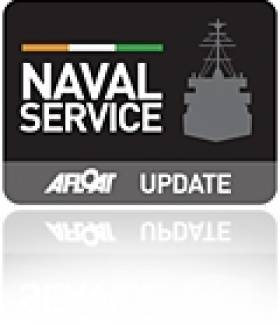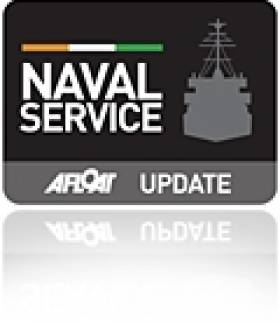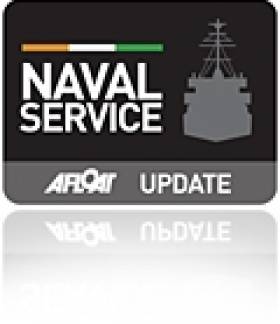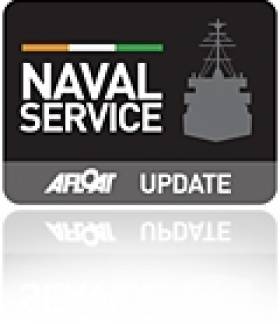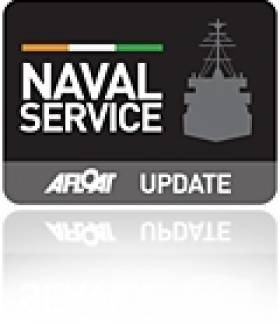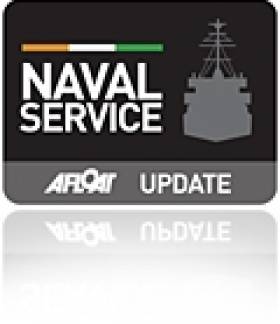Displaying items by tag: Navy
#NavyMedCrisis - For first time Ireland is to participate in an EU search and rescue mission, following the Government's decision to send a fully crewed ship to the Mediterranean to help with the rescue of migrants fleeing north Africa.
The ship could be dispatched within weeks, officials said, and will work alongside Triton, the EU's search and rescue mission in the Mediterranean.
EU leaders have agreed to triple the funding allocated to Triton, with German chancellor Angela Merkel pledging to commit more money if necessary, in order to alleviate the humanitarian crisis in the Mediterranean.
"If we need more money we will put up more money. We will not fail because of lack of funds," the German chancellor said in Brussels.
For much more on this story, The Irish Times reports HERE.
#OPVJamesJoyce – The Naval Service lastest newbuild James Joyce is currently dealing with technical issues, though the Department of Defence in response to Afloat.ie say the OPV is due for delivery in the coming weeks, writes Jehan Ashmore.
She is the second of a trio of OPV90 class newbuilds that were ordered from Babcock Marine in the UK that saw L.E. Samuel Beckett (P61) enter service last year.
The north Devon shipyard is working on addressing the technical issues of James Joyce following recent completion of sea trails, noting the first sea-trials took place last month.
Previously it was understood that the newbuild was to make a delivery voyage to Cork Harbour last month.
James Joyce is a direct replacement of the former 'Aoife' which was decommissioned last January after a career spanning 35 years.
31 Year-Old L.É. Eithne (P31) Is Venue to Launch of South Coast's Biggest Sailing Event
#SovereignNavy – The call of the Naval Service's L.É. Eithne (P31) to Dublin Port yesterday saw Simon Coveney T.D., Minister for Defence attend the launch of the ICRA Nationals and Sovereigns Cup to be held on the 24-27 June, writes Jehan Ashmore.
As previously reported on Afloat.ie the ICRA Nationals, the south coast's biggest sailing event of the year is to be hosted by Kinsale Yacht Club as part of its Sovereign's Cup event.
The launch held on board L.É.Eithne took place as part of a routine call to the capital where the 1984 built (HPV) Helicopter Patrol Vessel is now in her fourth decade in service since her commissioning also that year. The 31 year-old L.É.Eithne also shares the same number with that of the pennent number designated to the HPV where 'P31' is displayed on her bow.
Originally, she came equipped with French built 'Dauphin' helicopters of the Irish Air Corps that after duties could return to the stern heli-deck and be stowed in the adjoining hanger.
On her visit to the capital this saw her make an entrance on the Liffey having sailed upriver through the East-Link toll-lift bridge which as it happens was also completed in 1984.
The 1,900 tonnes vessel is one of three ageing patrol vessels all dating to 1984 out of seven-strong fleet based in the Naval Service HQ on Haulbowline Island in lower Cork Harbour.
Easily recognisable compared to fleetmates as the 80-metre L.É. Eithne has a larger superstructure and a pair of funnels.
She was launched nearby to the naval base in Rushbrooke at the Verolme Cork Dockyard. This would be the yard's final order before closing that same year.
A total crew of 55 (6 officers) serve on board the HPV which has a main armament consisting of a bow-mounted Bofors 57mm canon.
Secondary armament are a pair of 20mm Rheinmetall canons in addition to a variety of smaller arms ranging from 9mm pistol to a 7.62mm general purpose machine gun.
The 55 crew of L.É.Eithne in which six are officers had departed Dublin Port this afternoon that saw a southbound passage through Dublin Bay and out into the Irish Sea.
During her career the 7,000 nautical-mile range capable vessel has carried out numerous fishery patrol duties, related boardings and among other roles that of drug-interdiction duties.
She has also been tasked with deployments overseas along with becoming the first Naval Service ship to cross the Atlantic Ocean. On that occasion in 1986, the HPV visited the eastern seaboard of North America with calls to New York, Boston and Hamilton.
L.É.Eithne along with her fleetmates are to regain the usual total of eighth patrol vessels. This will be achieved when the newbuild OPV90 class James Joyce as previously reported is due for delivery next month.
She is the second of a trio of Enhanced 'Roisin' class vessels following last year's introduction of L.É. Samuel Beckett (P61).
The final unit due in 2016 represents a fleet renewal and modernisation programme when the remaining 'Emer' class offshore patrol vessel (OPV) L.É. Aisling (P23) is to be withdrawn.
#CommodoreBrett – In the obituaries page of The Irish Times: Commodore Liam Brett who has died aged 86, retired as the head of the Irish Navy in 1990.
As a seafarer, he was renowned for his ship handling and his ability to manoeuvre and turn vessels in the tightest of locations. As an officer, he was seen as firm but fair. In his leadership he displayed understanding and compassion and he enjoyed the respect of those he commanded.
William John Brett was born into a farming family in Cappauniac, Cahir, Co Tipperary, the second youngest of the 11 children of Thomas Brett and Bridget Pyne. After primary education at Ballydrehid National School, Kilmoyler, he attended the Christian Brothers School in Tipperary town.
He entered the Irish Naval Service in 1947, and joined the the Naval cadet class a year after the establishment of the service, at a time when training meant moving to the centre of British naval education on the south coast of England – a long way from his landlocked native county.
He received his midshipman training with the Royal Navy at Britannia Royal Naval College, Dartmouth. Sea time on board British ships allowed him to travel widely, from the home waters around Europe as far afield as Hong Kong, gaining valuable experience in the years immediately after the second World War.
For more about his career involving corvettes and the capture of the 'Claudia' click here.
#EnterDryDockVideo - Afloat.ie has been informed by the Department of Defence that sea-trials of Naval Service latest newbuild OPV90 James Joyce took place between 6-9 March with delivery due shortly, writes Jehan Ashmore.
As originally reported, the trials took place in the Bristol Channel which is accessed from the estuary to where her builder's yard, Babcock Marine & Technology is located in Appledore, Devon.
After her delivery to the Naval Service, the €54m newbuild is to be commissioned in May. Likewise of her predecessor and delivery of the third and final newbuild in late 2016, the trio will feature drone technology and un-manned mini submarine capability. This will dramatically improve surveillance and incident response times.
As previously reported on Afloat.ie, the dry-docking of LÉ Samuel Beckett (P61) in Cork Dockyard last month was a pre-scheduled period and the date of entering the facility can now be revealed to have begun on 23 February.
According to the Naval Service the dry-docking was standard practice with new vessels to ensure all is well with hull fittings and the ship's capability.
The above video footage only recently published was taken from L.E. Samuel Beckett's bridge-mounted camera view that overlooks the bow of the leadship OPV90 class.
The scene shown is of the OPV departing off the Naval Base's harbour berth on Haubowline Island in lower Cork Harbour. From there she makes the short passage upriver to Cork Dockyard.
As the OPV90 heads closer to Cork Dockyard, Afloat.ie had previously reported of a blue-hulled Russian research vessel among other crafts berthed along the quayside. This vessel was the Geolog Dmitriy Nalivkin of 1,935 tonnes built in 1995 during the Soviet era at a yard in Turku, Finland.
Next we see the LÉ Samuel Beckett (P61) swing into the dry-dock, or graving dock which is 165.5m (539ft) long by 22.5m (73ft) wide and with an access width of 21.3m (70ft).
The dockyard was originally established by James Wheeler in 1853. Currently, Cork Dockyard, is a member of the Burke Shipping Group which is a subsidiary of the Doyle Group.
Drones And Robotic Subs for New Naval Service Vessel
#Drones&Subs – The Naval Service will more than halve the age of its eight-vessel fleet, reports the Irish Independent, when the third ship in a €162m order is delivered by 2016.
The news came as the navy's second new vessel, James Joyce, is now concluding sea trials as previously reported on Afloat.ie, and will be delivered within weeks for commissioning in May.
A sister ship to the LE Samuel Beckett (P61) which was delivered (and commissioned) last year, James Joyce was built at Babcock Marine's shipyard in north Devon.
A third vessel, the order for which was confirmed by Taoiseach Enda Kenny, is now under construction and is scheduled for a late 2016 delivery.
The delivery of the as-yet-unnamed third offshore patrol vessel will dramatically reduce the age profile of the navy's Haulbowline-based fleet.
For much more, click for the report here.
Aoife’s Malta African Refugee Role? Almost Full Circle!
#AoifesFate? – Aoife's fate still remains as the former Naval Service OPV is according to the Department of Defence in active discussions with the Maltese authorities, writes Jehan Ashmore.
The department added, that negotiations in relation to the modalities to be agreed in relation to the transfer of ownership of the decommissioned LÉ Aoife (P22).
Should the 1979 built Aoife head for a new career in the Med with the Armed Forces of Malta (AFM) naval squadron (and despite the 'junk' comments) one of new roles would be to assist in the humanitarian crisis.
Be it to deploy 'Aoife' to assist in the effort to rescue refugees fleeing worn-torn regions of North Africa and beyond. In addition to migrants seeking a better life in Europe having taken to the water on boats also organised by people-traffickers.
Could this be somewhat full-circle for the former Naval Service patrol-ship? As the following is a piece I wrote for the Maritime Institute of Ireland's (National Maritime Museum of Ireland) Newsletter Winter 2003/04 and under the heading: Uniquely 'Unique'.
The story read: When going to work on November 5th, I noticed an unusual looking vessel at anchor south-east of Dun Laoghaire in Dublin Bay.The ship was a small coaster and of some vintage too and had characteristics unusual for ships calling to Dublin Bay these days.
It transpired that the vessel, the Mongolian registered 'Unique' was suspected of people-trafficking, as widely reported by the media. This activity turned out to be the first suspected incident of such a case in Irish waters.
The Naval Service L.E. Aoife arrived on November 6th in order to undertake inspections on board the Unique.
Despite searches of the ship and crew, no illegal persons or contraband where found. The Unique was subsequently escorted to Dublin Port on November 13th by the L.E. Ciara.
An Admiralty Court order for non-payment of wages for the crew of Unique were issued on behalf of the International Transport Federation (ITF).
It is now ironic to reflect on that historic incident of suspected people-trafficking and to have involved the deployment of L.E. Aoife from the 8-strong naval fleet.
As the Aoife is no longer in service, the fleet is reduced to 7 patrol vessels until newbuild OPV90 class James Joyce (on sea-trials) enters service this Spring?
As previously reported on Afloat.ie, Cork County Councillors call for Aoife to remain in the southern city as a floating museum. This would see the former OPV vessel as a museum near the Naval Service Base on Haulbowline, Cork Harbour, in the face of what's been taken as a "snub" by the Maltese.
A similar idea to keep Aoife in Irish waters was floated previously by a lobby group in Waterford. They campaigned for the veteran vessel to be kept along Waterford's quays and during her Naval Service days they designated the OPV's adopted 'homeport' to be that city. Aptly the south-eastern city is to where her decommissioning took place in January.
Aoife is currently berthed at the Naval Base. As for her exact location at the HQ's island complex, it is understood she is berthed within the Naval Basin alongside the former Irish Steel Plant. It is from this western quay of the basin is where the steel-plant received cargoships with scrap metal!
So watch this space and to wherever next?
‘James Joyce’ Second OPV90 Newbuild Starts Sea-Trials
#JamesJoyce – James Joyce began builders sea-trials today, she is the second of a trio of OPV90 class newbuilds ordered by the Department of Defence from a UK shipyard, writes Jehan Ashmore.
Afloat.ie has confirmed from the Department that an indicative date for the handover of the yet to be commissioned James Joyce will not be available until the sea trials are completed. She is to directly replace the decommissioned Aoife.
It is understood that James Joyce departed in the early hours of this morning from Appledore, north Devon from where she was built by Babcock Marine & Technology.
The yard on the banks of the River Torridge is from where her predecessor, leadship LÉ Samuel Beckett (P61) was also floated-out in late 2013.
On that occasion the inaugural newbuild also carried similar trials in the Bristol Channel which took place almost a year ago.
As recently reported, LÉ Samuel Beckett is undergoing annual maintenance works at Cork Dockyard.
A final sister also costing €54m was added to the original order for the first pair. The unnamed third newbuild will be launched from Appledore but not due for delivery until 2016.
#Asbestos- OPV90 class LÉ Samuel Beckett (P61) currently in Cork Dockyard for annual maintenance is where previously a pair of Naval Service CPV had asbestos removed early in the year, writes Jehan Ashmore.
Afloat.ie contacted the Department of Defence to comment on the current status of the CPV (Coastal Patrol Vessels). A spokesperson said that the Health & Safety Authority have indicated to the Naval Service that they are satisfied that all ship-related asbestos matters have been dealt with.
The cost to remove the dangerous material which was located in engine room spaces of the LÉ Orla (P41) and sister LÉ Ciara (P42) was in the region of €350,000.
Both CPV's had also undergone routine refit work at the dry-dock before returning last month to the Naval Base on Haulbowline, Cork Harbour, to where further works were carried out.
LÉ Orla is expected to resume operations by mid-March and LÉ Ciara is also expected to re-enter service at the end of this month.
Commodore Liam 'Willie' Brett R.I.P. 1929 - 2015
The death has taken place of Commodore (Retired) Liam Brett, former Flag Officer Commanding the Naval Service. Commodore Brett was instrumental in the expansion of the Naval Service beginning with the L.É. DEIRDRE in the early 1970s.
He was pivotal in the operations to detain the "Claudia" and the "Marita Anne" IRA gun running ships in the 70s and 80s, and also the Aer Lingus Viscount and the Air India recovery operations in his earlier years before commanding the Naval Service as Flag Officer until 1990.
He retired from the Naval Service after a 44 year career and is survived by his four children, son in law and five grand children.



























